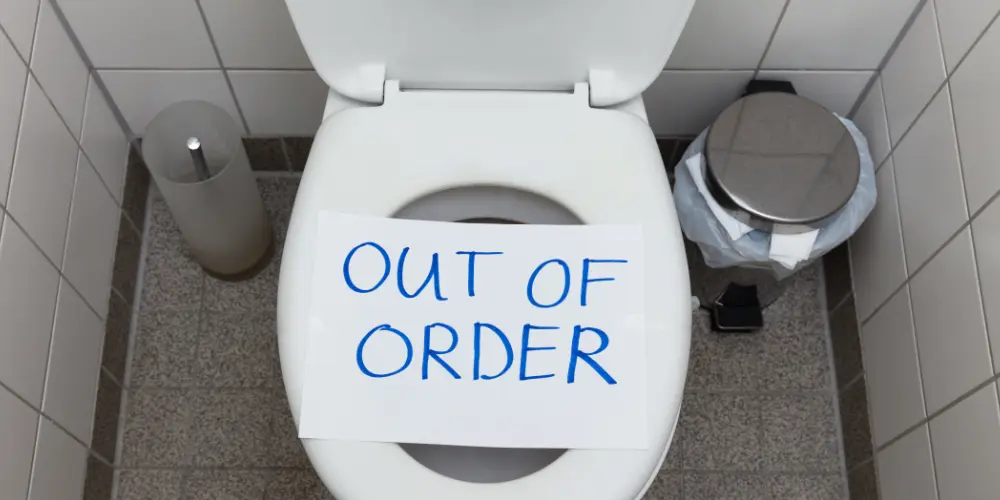We’ve all been there — helplessly watching the dirty water rise to the brim.
If we’re lucky, it won’t spill over. Otherwise, ugh.
An overflowing toilet is one of life’s inevitable misfortunes, especially if you have children. But when that toilet overflows as regularly as a bus on a schedule, it’s not just a matter of too much paper stuffed down the drain. Something else is going on.
The Science Behind Toilet Clogs
Yes, there’s a science to toilet clogs. It’s not rocket science, and it’s not a course of study at any American university (yet), but after the ninth toilet clog in a month, it probably deserves your attention.
Toilets flush waste using gravity and water pressure. When you push down on the handle, the flapper valve opens, letting water from the tank rush into the bowl. The sudden increased pressure pushes waste through the drain pipe and into the sewer system.
However, an obstruction in the drain pipe can disrupt this process and cause a clog. A constantly clogging toilet is more than a nuisance; it’s a fixture crying for help. Frequent clogging can indicate underlying issues that may lead to sewage backups, damage to the plumbing system, and expensive repairs.
So why does your toilet keep clogging? Here are the most common causes and how to fix them:
11 Common Causes of Toilet Clogs
1. Flushing Non-Flushables
Wipes, sanitary products, cotton balls, and even “flushable” wipes don’t break down easily in water. They can stick in your toilet’s pipes or block the sewer line. In 2017, a study by Water UK found that approximately 93% of materials causing sewer blockages were non-flushable wipes.
What to Do
- Avoid flushing non-flushable items altogether.
- Keep a trash bin near the toilet to dispose of these items.
2. Low-Flow Toilets
Toilets manufactured in the early 1990s, known as first-generation low-flow toilets, often lack the power to push waste through the plumbing. These earlier models use less water but at the cost of functionality, leading to more frequent clogs.
What to Do
- Consider upgrading to a newer model that combines water efficiency with effective flushing technology.
- If upgrading is not an option, use less toilet paper when flushing.
3. Hard Water Buildup
Hard water contains high levels of minerals like calcium and magnesium. These minerals can accumulate in your pipes and prevent proper drainage.
What to Do
- Regularly clean and descale your toilet with vinegar and baking soda.
- Install a water softener system to reduce the mineral content in your water.
4. Tree Roots in the Sewer Line
Trees on your property (or even your neighbor’s) may invade your sewer line looking for water. They can wrap around or penetrate the pipe, causing blockages.
What to Do
- Hire a professional plumber to inspect and remove tree roots from your sewer line.
- Consider planting trees or shrubs far away from the sewer line to prevent future root intrusion.
5. Old Age
Just like any other appliance, toilets have a lifespan. If you’ve had your toilet for over 20 years, it may be time to replace it.
What to Do
- Replace your old toilet with a newer, more efficient model.
- Regularly maintain and clean your toilet to extend its lifespan.
6. Foreign Objects
Children are notorious for flushing toys, toothbrushes, and other small objects down the toilet. These items can get stuck in the drain pipe or trap and cause clogs.
What to Do
- Avoid having children (relax, folks, it’s a joke)!
- Monitor children closely in the bathroom.
- Keep small objects away from tiny hands.
7. Septic Tank Issues
Do you have a septic tank? Has it been serviced recently? A full septic tank can clog in your sewage system.
What to Do
- Schedule regular maintenance and pumping.
- Avoid flushing grease, oil, and other non-biodegradable materials that can clog the system.
8. Improper Ventilation
Toilets need ventilation to function correctly. If your plumbing vent pipes are blocked, air can’t escape, leading to poor flushing.
What to Do
- Inspect your vent pipes for blockages or damages.
- Hire a professional plumber for repairs or maintenance if needed.
9. Flapper Valve Issues
The flapper valve releases water from the tank into the bowl during a flush. A malfunctioning flapper valve can reduce water flow and contribute to clogs.
What to Do
- Check the chain and make sure it’s not too long or too short.
- Replace the flapper valve if it’s worn out or damaged.
10. Too Much Toilet Paper
Excessive amounts of toilet paper can cause clogs, especially in low-flow toilets.
What to Do
- Avoid flushing thick or multiple-ply toilet paper that doesn’t break down easily in water.
- Use only as much toilet paper as needed.
- Switch to thinner and more biodegradable options.
11. Clogged Trap
The S-shaped trap within your toilet retains a small amount of water to prevent sewer gases from entering your home. However, it can also trap debris, leading to blockages.
What to Do
- Use a plunger or plumbing snake to dislodge debris.
- Regularly clean the trap with a mixture of hot water and dish soap.
Preventative Measures & Maintenance Tips
- Habitually check your plumbing system to catch early signs of wear and tear, which can prevent clogs.
- Encourage flushing only appropriate materials and conserving water to maintain plumbing health.
- Place a small trash bin in the bathroom to discourage flushing non-flushable items.
- Apply enzymatic drain cleaners monthly to help break down potential buildup.
FAQs: Why Your Toilet Keeps Clogging
Q: Why does my toilet keep clogging if I only flush toilet paper?
Too much toilet paper or low-flow toilets can still cause blockages. Reduce the amount of paper you flush or switch to a single-ply brand.
Q: Can I use chemical drain cleaners to unclog my toilet?
They can damage your pipes and create harmful fumes. Use a plunger or plumbing snake instead.
Q: How often should I clean my toilet to prevent clogs?
Clean and descale your toilet at least once a month to prevent buildup and clogs.
Q: What are some signs that my septic tank might be full?
Signs include slow drainage, sewage backups, and unpleasant odors around your property. Regular maintenance and timely pumping can help prevent these issues.
Q: How do I know if the flapper valve in my toilet is malfunctioning?
A defective flapper valve may cause inconsistent flushing, water running continuously, or a weak flush. Regularly check the flapper for wear and tear and ensure it creates a proper seal.
Q: Is it possible to clear a clogged toilet without professional help?
Yes, many clogs can be cleared with a plunger or plumbing snake. However, for severe or persistent clogs, seek professional assistance to prevent damage to your plumbing system.


